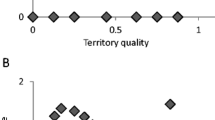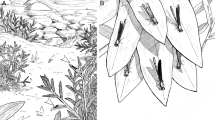Summary
In resource-defence mating systems we intutively expect that the most competitive males should win the best resources so that, in territorial species, male quality and territory quality will be highly correlated. In the “polygyny threshold model” (PTM) of mate choice this expectation has become an assumption. We performed a removal experiment using red-winged blackbirds to test the validity of this assumption. On the basis of two morphological and two behavioral indices of competitive ability we found only weak correlation between male competitive ability and territory quality. Factors potentially contributing to this result include habitat quality perception, site dominance, and site fidelity. However, both our experimental design and measurement of male competitive ability may have caused us to underestimate the real correlation between male quality and territory quality. Nevertheless, our results suggest that male quality is not perfectly correlated with territory quality as is assumed in the PTM. Therefore, male quality and territory quality should be treated independently when modelling mate choice in this and other territorial species.
Similar content being viewed by others
References
Aspey WP, Blankenship JE (1977) Spiders and snails and statistical tales: application of multivariate analysis to diverse ethological data. In: Hazlett BA (ed) Quantitative methods in the study of animal behaviour. Academic Press, NY, pp 75–120
Eckert CG, Weatherhead PJ (1987a) Male characteristics, parental quality and the study of mate choice in the red-winged blackbird (Agelaius phoeniceus). Behav Ecol Sociobiol 20:35–42
Eckert CG, Weatherhead PJ (1987b) Ideal dominance distributions: a test using red-winged blackbirds (Agelaius phoeniceus). Behav Ecol Sociobiol 20:43–52
Eckert CG, Weatherhead PJ (1987c) Owners, floaters and competitive asymmetries among territorial red-winged blackbirds. Anim Behav (in press)
Fretwell SD (1972) Populations in a seasonal environment. Princeton University Press, Princeton
Greenwood H, Weatherhead PJ (1982) Spring roosting dynamics of red-winged blackbirds: biological and management implications. Can J Zool 60:750–753
Hansen AJ, Rohwer S (1986) Coverable badges and resource defence in birds. Anim Behav 34:69–76
Heisterberg JF, Knittle CE, Bray OE, Mott DF, Besser JF (1984) Movements of radio-instrumented blackbirds and European starlings among winter roosts. J Wildl Manage 48:203–209
Holm CH (1973) Breeding sex ratios and reproductive success in the red-winged blackbird (Agelaius phoeniceus). Ecology 54:356–365
James FC (1970) Geographic size variation in birds and its relationship to climate. Ecology 51:365–390
Krebs JR (1971) Territory and breeding density in the great tit, Parus major L. Ecology 52:2–22
Krebs JR (1982) Territorial defence in the great tit, Parus major: do residents always win? Behav Ecol Sociobiol 11:185–194
Lenington S (1980) Female choice and polygyny in red-winged blackbirds. Anim Behav 28:347–361
Lenington S (1983) Commentary. In: Brush AH, Clark GA Jr (eds) Cambridge University Press, Cambridge, Mass, pp 85–91
Maynard Smith J, Parker GA (1976) The logic of asymmetric contests. Anim Behav 24:159–175
Muldal AM, Moffat JD, Robertson RJ (1986) Parental care of nestlings by male red-winged blackbirds, Agelaius phoeniceus. Behav Ecol Sociobiol 19:105–114
Orians GH (1961) The ecology of blackbird (Agelaius) social systems. Ecol Monogr 31:285–312
Orians GH (1969) On the evolution of mating systems in birds and mammals. Am Nat 103:285–312
Orians GH (1980) Some adaptations of marsh-nesting blackbirds. Princeton University Press, Princeton
Orians GH, Christman GM (1968) A comparative study of the behavior of the red-winged, tricolored and yellowheaded blackbirds. Univ Calif Publ Zool 84
Parker GA (1974) Assessment strategy and the evolution of fighting behavior. J Theor Biol 47:223–243
Patterson LB (1979) Relative parental investment in the red-winged blackbird. Unpubl. Ph D diss. Indiana University, Bloomington
Payne RB (1979) Sexual selection and intersexual differences in variance in bredding success. Am Nat 114:447–452
Picman J (1987) Territoriality in red-winged blackbirds: territory establishment, size and tenacity by males. Auk (in press)
Robertson RJ (1972) Optimal niche space in the Red-Winged Blackbird (Agelaius phoeniceus). I. Nesting success in marsh and upland habitat. Can J Zool 50:247–263
Rohwer S (1982) The evolution of reliable and unreliable badges of fighting ability. Am Zool 22:531–546
Searcy WA (1979a) Female choice of mates: A general model for birds and its application to red-winged blackbirds. Am Nat 114:77–100
Searcy WA (1979b) Morphological correlates of dominance in captive male red-winged blackbirds. Condor 81:417–420
Searcy WA (1979c) Male characteristics and pairing success in red-winged blackbirds. Auk 96:353–363
Searcy WA, Yasukawa K (1981) Does the sexy son hypothesis apply to mate choice in red-winged blackbirds? Am Nat 117:343–348
Searcy WA, Yasukawa K (1983) Sexual selection and red-winged blackbirds. Am Sci 71:166–174
Sokal RR, Rohlf FJ (1981) Biometry. 2nd edn. Freeman, San Francisco
Verner J (1964) The evolution of polygamy in the long-billed marsh wren. Evolution 18:252–261
Weatherhead PJ, Robertson RJ (1977a) Harem size, territory quality and reproductive success in the red-winged blackbird (Agelaius phoeniceus). Can J Zool 55:1261–1267
Weatherhead PJ, Robertson RJ (1977b) Male behavior and female recruitment in the red-winged blackbird. Wilson Bull 89:583–592
Weatherhead PJ, Robertson RJ (1979) Offspring quality and the polygyny threshold: “the sexy son hypothesis”. Am Nat 113:201–208
Weatherhead PJ, Robertson RJ (1981) In defence of the sexy son hypothesis. Am Nat 117:349–356
Williams GC (1966) Adaptation and natural selection: a critique on some current evolutionary thought. Princeton University Press, Princeton
Wittenberger JF (1976) The ecological factors selecting for polygyny in altricial birds. Am Nat 110:779–799
Wittenberger JF (1981) Time: a hidden dimension in the polygyny threshold model. Am Nat 118:803–822
Yasukawa K (1979) Territory establishment in red-winged blackbirds: importance of aggressive behavior and experience. Condor 81:358–364
Yasukawa K (1981) Male quality and female choice of mate in the red-winged blackbird (Agelaius phoeniceus). Ecology 62:922–929
Yasukawa K, Searcy WA (1982) Aggression in female red-winged blackbirds: a strategy to ensure male parental investment. Behav Ecol Sociobiol 11:13–17
Author information
Authors and Affiliations
Rights and permissions
About this article
Cite this article
Eckert, C.G., Weatherhead, P.J. Competition for territories in red-winged blackbirds: Is resource-holding potential realized?. Behav Ecol Sociobiol 20, 369–375 (1987). https://doi.org/10.1007/BF00300683
Received:
Accepted:
Issue Date:
DOI: https://doi.org/10.1007/BF00300683




